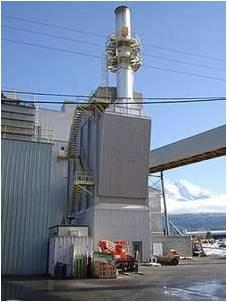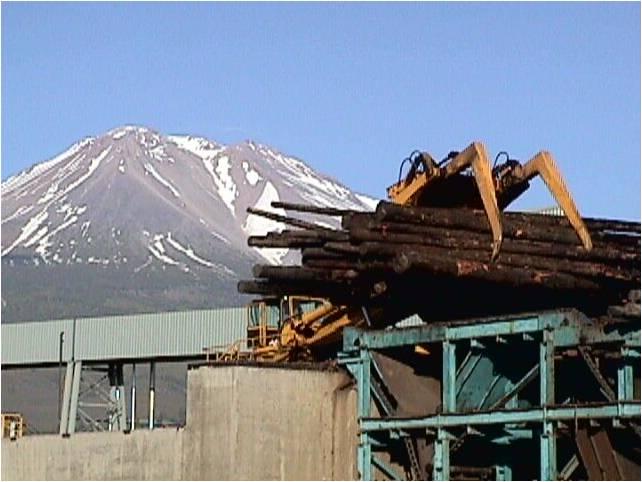|
NOVA ON TREES |
Home-Grown Fuel
By Dale Nova
Joint Coordinator
Fire Safe Council of Siskiyou County
 |
 |
Roseburg Forest Products, Weed, site of proposed new cogeneration plant
It is great news to many people, including the twenty Fire Safe Councils throughout Siskiyou County, that Roseburg Forest Products is moving forward with their electrical co-generation project in Weed.
We of the Fire Safe Council of Siskiyou County wholeheartedly endorse this type of project because it simply makes good sense, from not only an economic standpoint but also from a fire safe perspective. We need to offer incentives to our citizens, land managers, and businesses to help transform the lands they manage to properties that are cost-effective, healthier, and less fire-prone. We also need to grow living wage jobs and businesses in Siskiyou County, not export them!
With our present energy crisis deepening to alarming depths, now is the time to capitalize on alternative energy use so we can become more energy independent.
Presently, Pacific Power electrical generation is fired 38% by coal and 33% by natural gas. The combined emissions of these finite fossil fuels contribute to not only significant air pollution but also global warming. Additionally, large-scale hydroelectric projects provide Pacific Power with 24% of their energy resources, with the future chances of bigger hydro-dam building damned by voters in nearly every western state. Amazingly, biomass utilization is less than one percent of Pac Power’s energy production. This same amazing lack of renewable energy utilization is also evident with PG&E, Southern California Edison, and virtually all major California metro area energy producers, including the City of Redding, hydro power being excepted.
Biomass is renewable, and Siskiyou County’s forests are producing it in abundance, at an average rate of four times the reduction (harvest) rate. We need to collectively realize that biomass utilization is a positive solution to our economic downturn and plan strategically in Siskiyou County for its implementation. Using biomass as a sustainable energy source could be a critical key to unlocking the shackles for freeing up Siskiyou County’s economic development! Additionally, performing vegetative fuel reduction (biomass) around our communities means greater fire safety, which is essential to our very survival. It just make good sense, not to mention dollars, that we need more co-generation plants like Roseburg’s established throughout the county, ideally in every Siskiyou County community. What a big economic boost this could be for a struggling, subsistence-starved area like ours!
Please, we urge our friends, neighbors, business associates, and elected officials to eagerly endorse expediting biomass projects throughout Siskiyou County for our good and that of our future generations.
We need to utilize our biomass NOW or watch it burn in large wildfires, like those that burned last summer and autumn in Siskiyou County. Wildfires that will return, perhaps catastrophically, belching out quite possibly weeks if not many months worth of associated smokey, choking, health-hampering air quality, demanding convoys of thousands of fire vehicles, and producing great and grave threats to the lives of our brave firefighters. Let’s change this anathema now!!
TAMING THE FIRE BEAST
High up on Old McCloud Avenue above the town of Mount Shasta lives one of the grittiest guys I know. His name is Peter Chesko, and he lives in an area that is long overdue for a major wildfire event. Choked with manzanita, bitter cherry, pine thickets and oak trees loaded with dead-down-to-the-ground ladder fuels, this area is also planted sporadically with homes and structures in vulnerable circumstances perfect for the fire beast temperament of fire. Few homes in this 40-year-old heavily fire fuel-loaded subdivision would survive a wind-aided wildfire. Most of them are accessed only by single narrow same way in and out driveways. Not having a second escape route for long extended could be suicidal in the event of a fire. It would be possible suicide for a fire engine crew to take a stand at protecting many of these homes in a fast-moving, wind-driven wildfire.
Peter Chesko’s home environment is dramatically different than most of his neighbors. Over a period of fifteen years, he has quietly, conscientiously and persistently been reducing fuels on his two and a half acre parcel. He’s selectively thinned out the feedstock that the fire beast would consume and otherwise belch out a flame front loosed to run hell-roaring over the area testing the temerity of firefighters.
Starting small, Peter first began cutting along the parcel widened an opening through the thick, heavy ten-foot manzanita a short distance from his house. Using this as his first avenue of defense, he anchored his work from this path, widening it, selectively thinning out his over stocked pines, raising the canopy skirts a safe distance from the ground on all his trees to lessen opportunities for ground fire to climb up into his tree tops and race away.
Now, Peter Chesko’s parcel is park-like. The skinny pines selected to remain due to their spacing, form, and good health are now maturing, growing strong and stout. Oaks now offer ambiance, wildlife forage, and safety, instead of fuel ladders for ground fire to climb to tree tops then race like Sea Bisquet through forest.
A Sucker-Punched New Year
Our holiday festivities were just a fleeting memory by January
3rd when power-packed storms brought screaming winds, heavy snow, and drenching
rain that drowned out the hopeful wishes of launching a happy new year for many.
From Sacramento to the Oregon border, trees crashed onto homes, vehicles, and
other valuable property. Incredibly, no lives were lost in this storm series,
although several people were injured, some seriously. Roofs and roof sections
were stripped off buildings like banana peels.
Hundreds of thousands of people suffered electric power outages and shivered in
their cold homes, many wishing they could trade back their electric furnaces and
cookstoves for that sure-fire airtight wood stove that maybe was sold in that
yard sale a few summers before. Those suffering souls, some turned complacent by
the recent years of mild winters, were simply sucker-punched by Old Man Winter’s
wily ways.
By 7 a.m. on January 3rd, all of our tree service phone lines (thankfully, ours
weren’t down) were ringing as incessantly as those of the San Bernardino County
Fire Department during a Santa Ana wildfire siege. Many frantic callers had grim
reports: trees down on roofs with their homes taking in water; trees about to
uproot and crash onto buildings; trees wind-felled across driveways, eliminating
vehicle access. One person was trapped, unable to get out, when a tree fell
across the doorway.
Fire Departments, tree services, utility companies, insurance agencies,
snow-plow contractors and many other service providers in the North State were
barraged with more calls than a flock of turkeys on hot hunting grounds during
opening morning of wild spring turkey season. For our tree services, triage
tactics were employed as a strategy of coping during the first three days of the
storm siege. Our biggest challenge was finding property addresses not
prominently displayed and visible from the road using large reflective bold
numbers. First priority was to rig up trees that posed an immediate danger to
life and property and get them safely to the ground. After that, we worked on
those trees that were already down on roofs, cars, and driveways. Only by the
end of the second week did we even begin layer-three work: bucking up the trees
that were strewn across outbuildings, yards, and fences.
Roofs or roof sections were stripped off buildings like peelings from ripe
bananas. Hundres of thousands of people suffered power outages, some for several
days, and many shivering in cold homes wished they could trade back their
electric-fired furnaces and cookstoves for that sure-fire but sooty airtight
wood stove that they sold in that yard sale a few summers before. Those
complacent souls who had grown accustomed to Norther California’s recent years
of mild winters.
By 7 A.M. January 3rd, all of our tree services phone lines (thankfully, ours
weren’t down) were ringing as incessantly as those of the San Berardino County
Fire Department during a Santa Ana wildfire siege. Many frantic callers had grip
reports: trees down on roofs and taking in water; trees about to uproot and
crash onto buildings. Trees windfelled across driveways so the owners couldn’t
drive out to get to work. Even, “I’m trapped with a tree against the door and I
can’t get out!” Fire departments, tree services, utility companies, insurance
agencies, snow-plow contractors and many other service providers in the North
State were barraged with more calls than a flock of turkeys get on hot hunting
grounds during opening morning of spring wild turkey season.
For our tree services, triage tactics were straegically employed during the
first three days of this storm siege. Primary priority #1 was to rig up the
trees about to crush life or property and get those worse-threatening,
storm-damaged trees safely to the ground. After that, the layer #2 strategy
involved working off trees that were on roofs, cars, and driveways. Only by the
end of the second week did we begin layer #3 work: bucking up the trees that
were strewn across outbuildings, yards, and fences.
How many of us were prepared when that monstrous storm system slammed Northern
California the second night into the New Year. I think we all wish we had been
more ready!
Saturday morning January 19th was our tree-service crews’ first day in over two
weeks without climbing onto storm-damaged tree work. Our weary but unwhipped
crews met for a joint staff and safety meeting. During the debriefing segment,
many hazards and close calls were shared, evaluated, and solutions suggested.
Common denominators were deduced that had resulted in many tree failures. Our
arborists estimated over 40% of hazard trees involved were either dead trees, or
trees with canopies that were 50% dead or dying. Too many homeowners simply
trusted those dead or declining trees to safely stand firm through yet another
winter. Either from ignorance, indifference, arrogance or the quiet desperation
of economic hard times, too many folks hoped a happy new year would shine warm
blessings on them all for the 366 new days ahead. Yet by January 5th, many of
those same good people felt hammered harder than heavyweight champ Sonny Liston
the morning after his surprise single slugfest loss against a young-blooded and
fast-dancing quick Muhammad Ali, then known as Cassius Clay. Old man winter can
hit a lot sooner, swifter, stronger and with more surprise than many intelligent
people care to give him credit for.
What’s the best way to fight a clean fight, go all rounds with gust, keep our
guards up, and win with a decisive victory? Preparation, preventive action, and
professional performance! A tree consultation, a well-experienced certified
arborist is an inexpensive investment compared to a tree condemnation of a
once-stately but now treacherous storm-damaged hazard that could involved
considerable cash or, far worse, cost someone’s life.
Epilogue
Two more hard-hitting storm series struck upstate California on the 4th and 5th
weeks of the new year. Several storm-damaged trees worked by Able Tree Services
involved trees evaluated by this writer six months to three years prior with
prescriptions for positive tree care. In some cases, a few trees were
recommended for removal due to safety. In almost all cases, the costs would have
been much less than dealing with these trees after they became winter weather
hazards.
Who said an ounce of prevention is far less expensive than a pound of cure? Was
that my accountant?
Dale Nova is a certified arborist urban forester, and co-owner of Able Tree
Services.